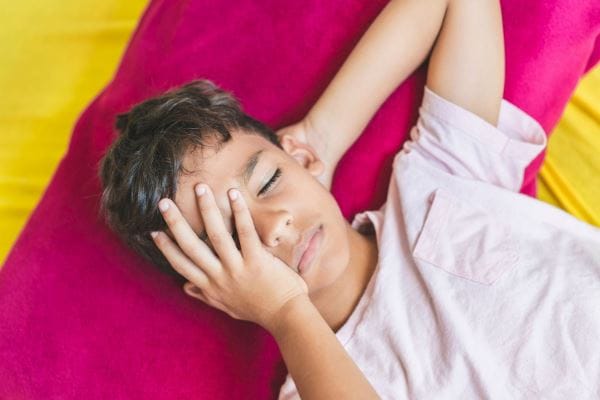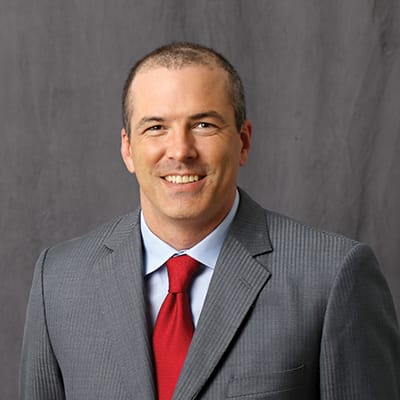A surprisingly common and completely correctable brain abnormality shouldn't be written off as just another headache.
Posted
by Featured Provider Nicholas Wetjen on Wednesday, October 14, 2020

Unless you know someone who has a Chiari malformation, you’ve probably never heard of it. Yet there’s a pretty good change you do know someone who has this brain abnormality and that they’re unaware of it themselves.
The lack of awareness is no cause for alarm. It just means that, for most people, a Chiari malformation causes no problems. But if your child complains of one specific symptom, this brain disorder must be corrected before things get serious.
Most kids with Chiari malformations show no symptoms.
A Chiari malformation is a neurological problem where part of the cerebellum — the back portion of the brain that controls coordination and movement — bulges through the opening where the skull meets the spinal cord.
You can’t see or feel where the bottom portion of cerebellum falls. And if the malformation isn’t putting pressure on the brain or spinal cord, your child won’t feel any other symptoms either.
“It’s actually a fairly common referral to neurosurgery. The most common reason is when a child or young adult gets an imaging study after either a head injury or for headaches,” says Nicholas M. Wetjen, MD, a pediatric neurosurgeon at The Iowa Clinic. “These structures called cerebellar tonsils, which are at the bottom part of the cerebellum, fall below the skull. If no symptoms are related to it, nothing needs to be done at all.”
This specific type of headache is the most common sign.
Headaches are a common complaint for many conditions, from allergies to influenza. But Chiari malformations cause a headache that you wouldn’t normally see.
“It’s a headache that’s generally in the back of the head or upper neck that gets worse with coughing or sneezing. That’s the characteristic headache of a Chiari malformation,” says Dr. Wetjen.
The headaches are severe and come on suddenly after a cough, sneeze and any other type of straining or exertion. The onset of these headaches typically comes later in childhood and may be accompanied by other serious symptoms:
- Balance problems and an unsteady gait
- Dizziness
- Poor hand coordination and a loss of fine motor skills
- Numbness and tingling in the hands or feet
- Trouble swallowing
- A hoarse voice
- Changing bladder and bowel habits
 Your Child’s Health Is Our #1 Priority, Too
Your Child’s Health Is Our #1 Priority, Too
Trust Central Iowa’s most experienced pediatric neurosurgeon, Dr. Nicholas Wetjen.
Meet Dr. Wetjen
This specific type of headache is the most common sign.
Most cases of Chiari malformation are discovered in a child’s late teens — often by accident. It could be because kids are old enough to accurately describe the symptoms that lead to a diagnosis or experience another issue that requires medical imaging of the brain.
These classic cases are considered Chiari malformation type 1. But there are multiple types that range in severity. And they can all occur much sooner in life.
Babies can be born with it. Toddlers may develop it if they’re skull doesn’t expand enough to hold their growing brain.
It’s likely that most cases start at this time. They just aren’t found until later life because little ones can’t tell you that their head hurts. And their coordination, balance and bladder control are all still developing, so their symptoms are going to present a little bit differently, Dr. Wetjen says.
“Infants and toddlers can have Chiari malformations but they can’t tell us they have headaches. Instead, they usually have irritability. Sometimes they have vocal cord dysfunction or trouble swallowing. They will occasionally have sleep apnea. And they may have weakness on one or both sides of their body.”
“But a lot of other things can mimic those symptoms,” he adds. “Those other things might need to be addressed first before you get to Chiari malformation.”
For little kids, that may involve extensive work from a wide range of experts in a truly multidisciplinary approach — starting with your pediatrician.
As a parent, you can closely watch how your child acts for any inclination that the way they’re behaving is a subtle sign of that hallmark headache. They might be more than irritable or fussy, they may cry more often. Or they might moan and groan, showing that they’re just not feeling well. Watch for how they react after coughing, sneezing or straining to see if they send these signals.
Brain surgery is the cure for Chiari malformation.
The severe headaches don’t go away by popping some acetaminophen or ibuprofen. Without corrective surgery the headaches, pain and other symptoms may even get worse. Chiari malformation can become a progressive disorder that leads to more serious neurological complications like weakness, numbness, chronic pain, imbalance and difficulties with swallowing. And it can be difficult to reverse serious symptoms once they occur.
“The operation is pretty low-risk and only takes about an hour,” assures Dr. Wetjen. “Most kids are in the hospital for a day or two and have a sore neck for a couple of weeks.”
With the help of physical therapy to restore the movement of the neck and keep it from getting stiff, kids are usually feeling better by four to six weeks. They can get back to school even before that, between one and three weeks.
“It’s important to go to a center that has experience taking care of these kids,” says Dr. Wetjen. “We have all the people in place here to manage it effectively.”
Meet This Featured Provider

Learn More About:
Neurological & Spinal Surgery,
Spine Center
Nicholas M. Wetjen, MD joined The Iowa Clinic after directing Pediatric Neurosurgery at the Mayo Clinic in Rochester, Minnesota for nearly ten years. He chose The Iowa Clinic because of the talented team of surgeons who provide exceptional neurosurgical care right here in his home state of Iowa.<... Read More
Accepting New Patients
Other Neurological & Spinal Surgery
Tags
- neurosurgery
- pediatric neurosurgery
- pediatrics